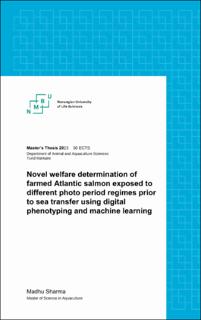| dc.description.abstract | The well-being of fish must be a priority as fish have cognitive abilities and good welfare is a must for optimum production. The purpose of the research was to determine welfare of Atlantic salmon exposed to different light regimes prior to seawater transfer: 8 hours of light:16 hours of darkness, 12 hours of light:12 hours of darkness, 24 hours of light:0 hours of darkness for six weeks, thereafter all treatment groups were exposed to a continuous light regime of 24 hours light:0 hours darkness for six weeks. The PIT-tagged fish were sampled for analysis prior to sea water transfer in June 2021, 3 months after transfer in November 2021 and before harvesting in April 2022. Fish were weighed, measured for fish length, and individually photographed at all three samplings. The images were then analyzed using ImageJ software, where the wound area and affected area surrounding the wounds were calculated. Welfare scoring was also done, including scale loss, looser fish (emaciation), jaw deformity, skin hemorrhages, eye hemorrhages, cataract, dorsal fin damage(active), dorsal fin damage (healed), and cataract. The results from ImageJ were compared with the result from machine learning algorithm.
Prior to sea water transfer the fish had no wounds, whereas in November 9.45 % of the fish population had wounds. In April, 48.4% of the fish had wounds. The results showed that a relatively high variation in biometric traits is expected among individual salmon farmed in seawater, independent of light treatment in freshwater. Nevertheless, 24-hour light treatment in freshwater appeared to be preferable for body growth and condition factor in the long-term in seawater, without compromising fish welfare due to skin issues, including ulcers. Salmon exposed to 12 hours light and 12 hours darkness in freshwater appeared to have highest prevalence of dorsal fin damages. However, calculated growth in seawater (TGC and SGC) was similar for all light treatments in freshwater. Image analyses, and particularly machine learning based on images, show a promising potential for efficient determination of fish welfare issues such as skin ulcers in Atlantic salmon. | |
